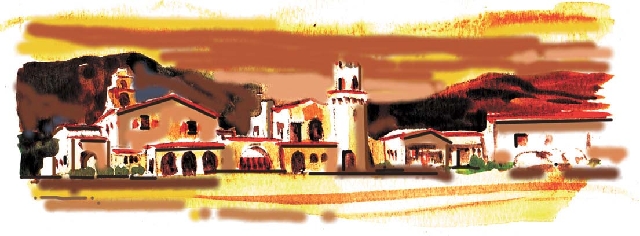Scotty’s Castle home to opulent, colorful history

Scotty’s Castle in Death Valley National Park offers a glimpse into an opulent era in history, continuing to draw curiosity seekers much as it has since construction began on the Spanish-style mansion at Death Valley Ranch in remote Grapevine Canyon in 1924.
Nowadays, highways speed visitors to Scotty’s Castle, a big improvement over the railroad spur and rough tracks that provided access to the area in the 1920s.
Scotty’s Castle is 175 miles from Las Vegas. Drive north on U.S. Highway 95 through Beatty to the turnoff on California Route 267 at Scotty’s Junction. The road cuts south 25 miles to Death Valley Ranch.
In the early 20th century, many well-heeled Americans built impressive abodes, both as regular residences and vacation retreats. A rich Midwesterner, Albert M. Johnson dreamed of the desert mansion as a peaceful part-time getaway after falling for Death Valley while visiting the area in the early 1900s. He had come there to investigate his investment in a gold mining scheme.
The author of that scheme, a colorful character and con man named Walter Scott, guided him on a Death Valley camping trip that left Johnson a changed man.
Johnson and his wife, Bessie, returned several times, bought the well-watered ranch property and befriended Scott, better known as Death Valley Scotty.
As legends grew about the mansion, Johnson let Scotty call the house his own. He often greeted visitors, regaling them with stories of the Old West. Scotty had a knack for telling tall tales, informed by his life experience that included a dozen years as a rider with Buffalo Bill’s Wild West Show. Scotty lived in Death Valley until his death in 1954.
Visitors to Scotty’s Castle pay a $20 national park entry fee at the information center, a charge that is waived for holders of federal recreation passes. Explore Death Valley Ranch on self-guided tours of the grounds before joining park rangers for interior or underground tours or take a guided hike to a rustic home built for Scotty.
Short trails take visitors to various points of interest near the house, including a recently restored cookhouse. Outbuildings contain an assemblage of early vehicles, equipment and building materials imported for construction of Scotty’s Castle. Peruse the displays in the information center or browse through the bookstore.
Avoid a long wait for a tour, by purchasing tickets in advance at recreation.gov online or by calling 877-444-6777. Tickets for the interior house tour and the underground tour are $15 each or $25 for a combination tour. The Lower Vine Ranch Hiking Tour costs $20. Pass holders and visitors ages 6 to 16 pay half price. Children 5 and younger tour for free.
Limited to 19 visitors at a time, the house tour takes about 50 minutes, running from 9 a.m. to 5 p.m. Accommodations can be made for disabled visitors.
Rangers guiding the tours wear 1930s costumes to add to the house’s ambiance. Its original owners spared no expense. Imported materials and fine craftsmanship are found throughout the mansion.
The house prospers under the careful restoration and preservation planned by the National Park Service. Note the beautiful Native American baskets collected by Bessie Johnson. Most were woven by Death Valley native people whose families lived nearby or worked on the construction. The Park Service has carefully catalogued these artifacts.
The Underground Mysteries Tour reveals the technologies used to heat, cool, pipe water and provide power to the self-sufficient mansion, including an original Pelton water wheel that generated electricity. Restricted to 15 people, this tour lasts about an hour and requires that visitors wear a hard hat. It is not wheelchair accessible.
The Lower Vine Hiking Tour takes participants to an area normally closed to public access. The tour takes 2½ hours and involves a two-mile walk not suited for small children or disabled visitors. Wear sturdy walking shoes, sunblock and insect repellent. Carry bottled water.
Margo Bartlett Pesek’s Trip of the Week column appears on Sundays.